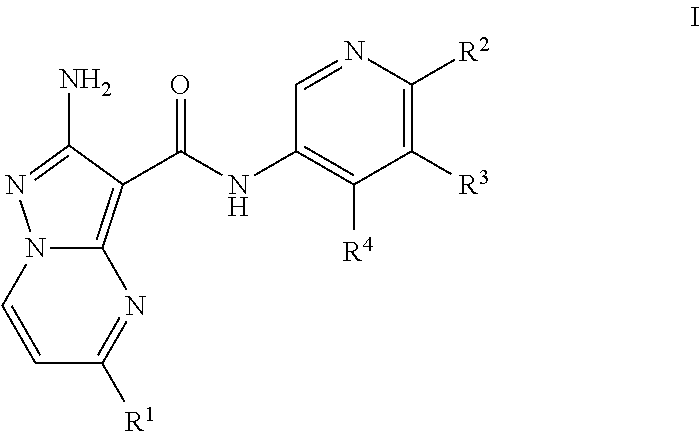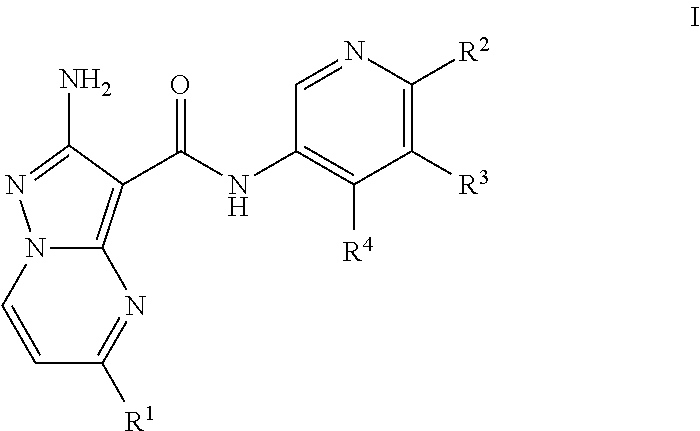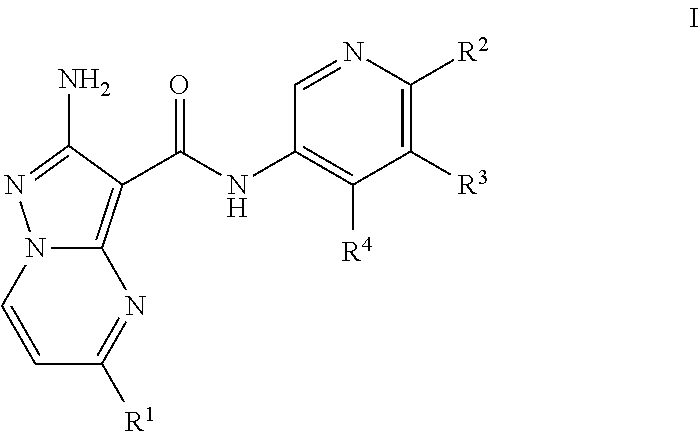Compounds useful as inhibitors of atr kinase
a technology of atr kinase and compounds, which is applied in the direction of heterocyclic compound active ingredients, drug compositions, biocides, etc., can solve problems such as dna damag
- Summary
- Abstract
- Description
- Claims
- Application Information
AI Technical Summary
Benefits of technology
Problems solved by technology
Method used
Image
Examples
example 1
2-amino-N-(4-methoxypyridin-3-yl)-5-(trifluoromethyl)pyrazolo[1,5-a]pyrimidine-3-carboxamide (Compound I-O-1)
[0301]2-Amino-5-(trifluoromethyl)pyrazolo[1,5-a]pyrimidine-3-carboxylic acid 5a (100 mg, 0.4063 mmol), 4-methoxypyridin-3-amine (50.44 mg, 0.4063 mmol) and DIPEA (52.51 mg, 70.77 μL, 0.4063 mmol) were dissolved in dry NMP (812.6 μL) in a microwave tube. TBTU (130.5 mg, 0.4063 mmol) was added in one portion and the resulting mixture was stirred at RT for ˜10 minutes and at 100° C. for ˜2 h under microwave conditions. The reaction mixture was allowed to cool to RT and filtered through a SCX-2 cartridge (5 g). The cartridge was washed with MeOH / DCM and eluted with 2M NH3 in MeOH (3×10 mL). The eluate was concentrated under reduced pressure. The residue was purified by column chromatography on silica (7.5% MeOH in DCM, ˜75 mL) to give the desired Compound I-0-1 as a bright yellow solid (87.9 mg, 61% Yield). LC-MS (M+H)+353.1; 1H NMR (500 MHz, DMSO-d6) δ 9.93 (s, 1H), 9.55 (s, 1H)...
example 2
2-amino-N-(4-methylpyridin-3-yl)-5-(trifluoromethyl)pyrazolo[1,5-a]pyrimidine-3-carboxamide (Compound I-C-1)
[0302]To a solution of benzotriazol-1-yl 2-amino-5-(trifluoromethyl)pyrazolo[1,5-a]pyrimidine-3-carboxylate 6a (150 mg, 0.4129 mmol) in NMP (1.666 mL) was added 4-methylpyridin-3-amine (44.65 mg, 0.4129 mmol) and the reaction mixture was stirred at 100° C. for 17 hours in a sealed tube. The solid precipitate was filtered and dried under vacuum to afford the desired Compound I-C-1 as a yellow powder (60.4 mg, 42%). LC-MS (M+H)+ 337.2; 1H NMR (500 MHz, DMSO-d6) δ 9.45 (s, 1H), 9.40 (s, 1H), 9.30 (dd, J=6.9, 0.6 Hz, 1H), 8.22 (d, J=4.7 Hz, 1H), 7.52 (d, J=6.9 Hz, 1H), 7.33 (d, J=4.8 Hz, 1H), 7.01 (s, 2H), 2.42 (s, 3H).
example 3
2-amino-N-(4-(piperidin-4-yloxy)pyridin-3-yl)-5-(trifluoromethyl)pyrazolo[1,5-a]pyrimidine-3-carboxamide (Compound I-O-41)
[0303]The Boc-protected precursor of I-O-41 (130 mg) was dissolved in DCM (550 μL) and TFA (21.55 mg, 14.56 μL, 0.189 mmol) was added. The reaction mixture was stirred at ambient temperature for 1 hour and then filtered through a SCX-2 cartridge (2 g) which was washed with DCM / Methanol (1:1, 3×8 mL) and then eluted with 2 M ammonia in methanolic solution (2×8 mL). The eluate was evaporated and the residue was purified by HPLC to afford the desired compound I-O-41 as a bright yellow solid (51 mg, 64%). LC-MS (M+H)+ 422.1; 1H NMR (500 MHz, DMSO-d6) δ 9.34 (d, J=8.5 Hz, 2H), 9.26 (d, J=6.9 Hz, 1H), 8.19 (d, J=5.6 Hz, 1H), 7.50 (d, J=6.9 Hz, 1H), 7.24 (d, J=5.7 Hz, 1H), 7.02 (s, 2H), 4.67 (tt, J=9.4, 4.2 Hz, 1H), 2.95 (dt, J=12.4, 4.2 Hz, 2H), 2.60 (ddd, J=13.0, 10.7, 2.7 Hz, 2H), 1.97 (dq, J=11.8, 3.8 Hz, 2H), 1.55 (dtd, J=14.1, 10.3, 4.0 Hz, 2H); 19F NMR (471 MHz, ...
PUM
| Property | Measurement | Unit |
|---|---|---|
| reaction temperature | aaaaa | aaaaa |
| reaction temperature | aaaaa | aaaaa |
| temperature | aaaaa | aaaaa |
Abstract
Description
Claims
Application Information
 Login to View More
Login to View More - R&D
- Intellectual Property
- Life Sciences
- Materials
- Tech Scout
- Unparalleled Data Quality
- Higher Quality Content
- 60% Fewer Hallucinations
Browse by: Latest US Patents, China's latest patents, Technical Efficacy Thesaurus, Application Domain, Technology Topic, Popular Technical Reports.
© 2025 PatSnap. All rights reserved.Legal|Privacy policy|Modern Slavery Act Transparency Statement|Sitemap|About US| Contact US: help@patsnap.com



